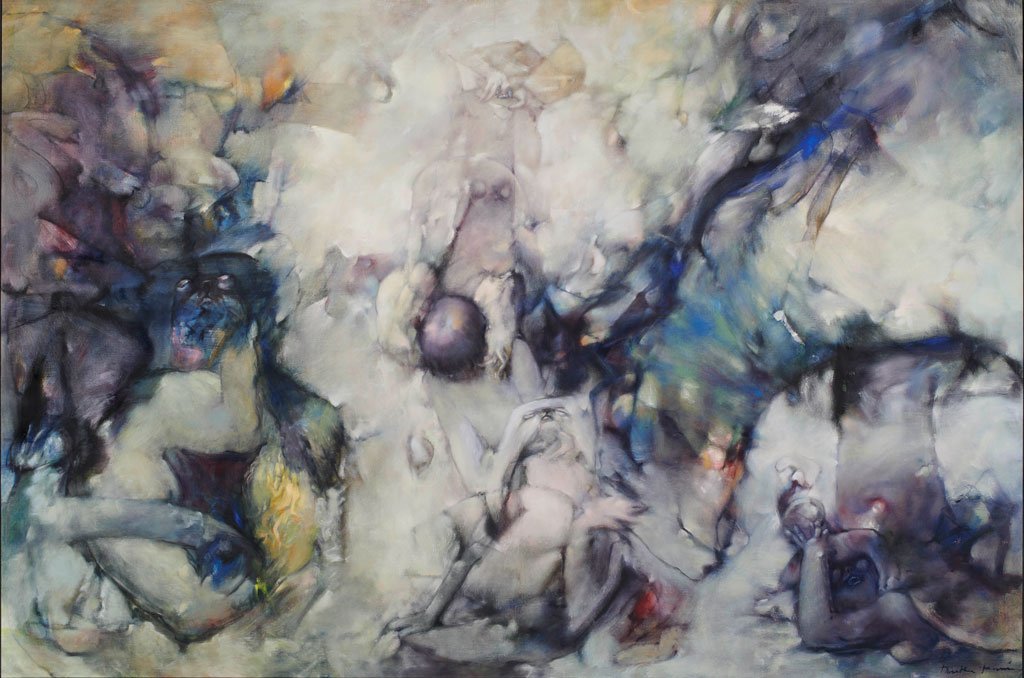‘Art has always been the raft onto which we climb to save our sanity. I don't see a different purpose for it now.’
– Dorothea Tanning, 2002
In 2019, Tate Modern held the first large-scale exhibition of American artist Dorothea Tanning in 25 years, bringing together 100 works from her 70 year career – enigmatic paintings and sculpture.
Dorothea Tanning (1910 – 2012) was born in Galesburg, Illinois, a town where “nothing happened except the wallpaper”, she said. It’s claimed her childhood was repressed and tedious and it wasn’t until she arrived in New York and fell in with the surrealists that she found her true self. She wasn’t keen to explain what the inspirations were for her disturbing night fantasies or what exactly was going on. But she enjoyed an enduring career as a painter, sculptor and writer. And this despite living in the shadows of her famous husband Max Ernst for 30 years.
Dorothea Tanning with Max Ernst
It was Tanning’s powerful 1942 self portrait ‘Birthday’ that first attracted the attention of Ernst. Later he divorced his third wife Peggy Guggenheim and married Tanning in a curious joint ceremony with Man Ray and Juliet Browner in 1946. Afterwards, Tanning and Ernst moved to Sedona, Arizona where they built a house and immersed themselves in their art. So harsh was the landscape that sunflowers were about the only flower that could survive there.
Birthday, 1942, oil on canvas, 102 x 65 cm
She said she wanted to depict “unknown but knowable states”, to suggest there was more to life than meets the eye. She wanted to combine the familiar with the strange to create an unsettling surrealist space. Her most famous painting, Eine Kleine Nachtmusik (A Little Night Music) from 1943 got its title from a Mozart serenade and it’s not clear if we are looking at 2 girls, or the same girl before and after seeing the threatening sunflower. It’s thought that the girls are Dorothea Tanning and that the painting was inspired by a nightmare. The whole painting reeks of subconscious anxiety and the sunflower is thought to be a masculine presence. Perhaps some childhood trauma is being remembered here.
Eine Kleine Nachtmusik, 1943, oil on canvas 41 x 61 cm
“Please don’t ask me to explain my paintings, I don’t think it’s possible. I paint, I can only describe this as a drive.”
It no doubt grated with her that for years she was labelled a woman surrealist. From the mid 1950’s, her work became more abstract reflecting her passion for dance, music and performance - perhaps combined with her earlier love of gothic and romantic literature.
Dogs of Cynthera 1963, oil on canvas, 197 x 297 cm
In the mid 1960’s she and Ernst moved to Paris and she declared that she was “fed up with turpentine” after which she began to produce soft sculptures using her Singer sewing machine. This resulted in her installation ‘Hotel Du Pavot – Chambre 202’ of 1970-73 which consists of figures seemingly trying to escape the hotel room (perhaps the same hotel from Eine Kleine Nachtmusik). Furniture seems to be metamorphosing into limbs, thighs and the scene is almost macabre. “I set myself terrible goals” she once said. “People said these sculptures are too soft, they won’t last. They might as well have said they are dead”. Her message may have been that life and love are soft and won’t last forever hence there is a deliberate fragility in her sculptures.
Hotel Du Pavot, 1970-73, installation, wool fabric synthetic fur and ping pong balls
Tanning believes this work to be directly related to a song popular in her childhood.
In room two hundred and two
The walls keep talkin' to you
I'll never tell you what they said
So turn out the light and come to bed.
The song was written in the 1920’s and laments the fate of Kitty Kane, a one-time Chicago gangster’s wife who poisoned herself in room 202 of a local hotel.
Like so many artists, Tanning’s art was her means of understanding the world around her. She continued to write until the end – her last book of poems was published when she turned 100.
“I’ve done everything I could to escape my biography, but I think we’re prisoners of our events.”
Tanning at the Tate exhibition. The painting to her left is 'Tango Lives' from 1977
References;
Dreamideamachine.com
Tate.org.uk
The Art of the Dark, BBC TV
dorotheatanning.org





